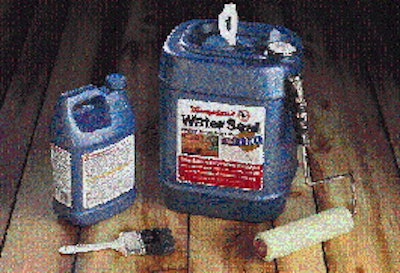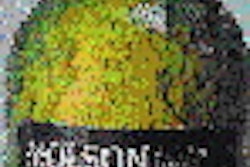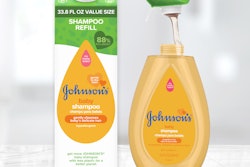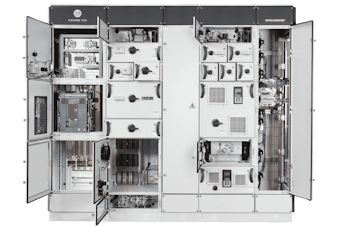Beading water on an outdoor deck has long been the symbol for the efficacy of Thompson's Water Seal, a wood treatment product from Thompson & Formby, Memphis, TN. Last year, the company developed a new formula called Thompson's® Water Seal® Ultra waterproofer, a water-based sealer that delivers the best multi-surface waterproofing protection available. To attract new users, the company employed totally new packaging: * In place of Thompson's traditional steel containers, Ultra is packaged in high-density polyethylene containers, made using Thompson's signature pearlized blue color. * Replacing litho-printed containers, the Ultra containers use an unusual combination of in-mold, pressure-sensitive and heat-transfer labeling-all depending on the container size and the information needed. New formula the key "We've had very few plastic packages in the past," says Mike Tune, packaging engineer at Thompson & Formby's plant in Olive Branch, MO. "Our objective was to develop a package that would quickly convey the premium image of a premium product." He goes on to say that with a product that retails for $15 per gallon, packaging components weren't a strong economic issue. When development was completed last year, Thompson settled on two containers of HDPE: one is a 1-gal jug from Continental Plastic Containers (Norwalk, CT); the other a one-piece blow-molded 20-L tight-head drum made by NAMPAC (Atlanta, GA), a unit of Southcorp Packaging of Australia. Both use a pearlized deep blue colorant that Thompson feels is the signature color of its water seal product. Both sizes are supplied predecorated to Thompson. For the 20-L or 5-gal round drum, NAMPAC applies two large labels applied via Therimage® heat-transfer process by Avery Dennison (Framingham, MA). The molder also applies a plastic handle to the top of the container, and supplies a Flexspout® tamper-evident pouring spout from Rieke Corp. (Auburn, IN). On its part, CPC applies front and back labels in-mold; side labels are applied with pressure-sensitive applicating equipment. In fact, all labels are supplied by Avery Dennison, whether in-mold or p-s. Front and back in-mold labels are printed in four process and two match colors; the p-s labels are either three- or four-color. What made the introduction of Water Seal Ultra rather difficult for Thompson's is that the new product was designed to attract new users, not cannibalize existing customers who were very satisfied with the well established Thompson's Water Seal, a solvent-based product in steel containers. "We're bringing new users to the category with Water Seal Ultra waterproofer," Wilson says. "We believe we're attracting users who heretofore have been reluctant to get into solvent products." The new water-based product does have some major advantages: improved waterproofing; immediate use on pressure-treated lumber; soap and water clean-up; and a product that's milky white during application, yet dries clear. Why four labels? The four labels on the 1-gal size container really serve two purposes for Thompson. One is to merchandise the product. The other is to incorporate all the label copy that a chemical product like Water Seal Ultra is required to display. "We've got a lot of copy that simply wouldn't fit on the front and back labels of the 1-gal size container," says Tune. "The five-gallon size container permits a label size that's big enough to merchandise the product as well as to instruct and inform the consumer. Part of the issue is the copy that's required by the government, but a lot of the copy includes helpful hints to the user." "It's an understatement to say that in-mold labeling placement is more precise than a machine-applied label," Wilson states. "We've been delighted with the appearance of the in-mold labels." Unfortunately, Thompson could find no vendor with in-mold labeling capability on the 5-gal size. "We went with heat-transfer labeling on it because it's a proven technology that stands up to our retail environment." Tune adds that Therimage labels on the 5-gal containers really helps set Thompson apart from competitors in that size. Although few customers or consumers credit the package for its communicative function, Wilson is convinced it plays an important role. "When we've talked with the trade or the consumer about packaging, they've all been very impressed with what we've done. This is true for the color of the container, because there's nothing quite like it in the category. And the high-quality label reinforces our premium product. We don't get comments about the packaging unsolicited. But when we ask, those are the comments we receive."























